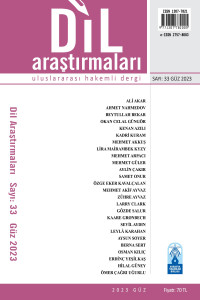Öz
Bu çalışmada Karahanlı Türkçesi dönemine ait Dîvânu Lügâti’t Türk, Kutadgu Bilig, Atebetü’l Hakayık, Divân-ı Hikmet, TİEM 73 ve Rylands Kur’ân Tercümesinde geçen ıd-~ıy- fiilinin yönettiği hâl eklerinin oluşturduğu istem çerçeveleri sözdizimsel bağlamda incelenecektir. Id-/ ıy- fiili örneklerine Divân-ı Hikmet’te rastlanmamıştır. Atebetü’l Hakâyık’ta çok sınırlı olmakla birlikte örnekler çoğunlukla Kutadgu Bilig’den ve Karahanlı Türkçesi Kurân tercümelerinden derlenmiştir. Karahanlı Türkçesi dönemindeki ıd- fiilinin art zamanlı istem görünümlerinin betimlenmesi, belli bir dönemde hâl eklerinin fiillerle kurduğu bağlantıları aktarmak adına önemli olacaktır. Id- fiilinin söz diziminde yalın, belirtme, ilgi, ayrılma, bulunma ve yön gösterme hâl ekleriyle ne ölçüde gramatikal bağlantı kurduğu metin merkezli aktarılacaktır. Çalışmanın sınırlarına sadece ıd- fiili dahil edilmiştir. Başta TİEM 73 ve Rylands Kurân tercümeleri olmak üzere ıd- fiilinin yer aldığı yan cümleler, birleşik fiiller, edilgen ve olumsuz yapılarının istem çerçeveleri başka çalışmaların konusu olarak bırakılmıştır. Bu bağlamda ıd- fiilinin Karahanlı Türkçesi dönemi metinlerinde hâl ekleriyle bağlantı kurduğu morfolojik ve gramatikal kategoriler, yer aldığı söz dizim/ cümle yapıları içerisinde betimlenecektir.
Anahtar Kelimeler
Dîvânu Lügâti't Türk Kutadgu Bilig Atebetü'l Hakayık Divân-ı Hikmet TİEM 73 Rylands Kur'ân Tercümesi Id- Fiili İstem
Kaynakça
- AKERSON, ERKMAN, Fatma (2016). Türkçe Örneklerle Dile Genel Bir Bakış. İstanbul: Bilge Kültür Sanat.
- ARAT, Rahmeti, Reşit (1979). Kutadgu Bilig I- Metin. Ankara: Türk Dil Kurumu.
- ARAT, Rahmeti, Reşit (1988). Kutadgu Bilig II- Çeviri. Ankara: Türk Tarih Kurumu.
- ARAT, Rahmeti, Reşit (1992). Atebetü’l Hakayık. Ankara: Kültür Bakanlığı.
- ATA, Aysu (2019). Karahanlı Türkçesinde İlk Kur’an Tercümesi Rylands Nüshası, Giriş- Metin- Notlar- Dizin. Ankara: Türk Dil Kurumu.
- ATALAY, Besim (2021). Dîvanu Lugâti’t Türk I-II. Ankara: Türk Dil Kurumu.
- BANGUOĞLU, Tahsin (2019). Türkçenin Grameri. Ankara: Türk Dil Kurumu.
- BOZ, Erdoğan (2008).Dîvânu Lügâti’t-Türk’te Belirli ve Belirsiz Nesne Yapıları. Journal of Turkish Studies, 3/1: 236- 241.
- BURAN, Ahmet (1989). Anadolu Ağızlarında İsim Çekim Ekleri. Doktora Tezi. Elazığ: Fırat Üniversitesi.
- CANPOLAT Mustafa (1992), “Eski Anadolu Türkçesindeki Belirtme Durumu (Accusativus) Ekinin Kökeni Üzerine”. Türkoloji Dergisi, 10: 9-13.
Öz
In this study, it will be investigated valency frame that created case suffixes ruled by the verb of ıd-, which is in Dîvânu Lügâti’t Türk, Kutadgu Bilig, Atebetü’l Hakayık, Divân-ı Hikmet, TİEM 73 and translation of Rylands Kur’an belonging to the Karakhanid Turkic period in syntactic context. The examples of verb ıd-/ ıy- have not encountered in the Divan-ı Hikmet. Although bounded in Atebetü’l Hakâyık, the examples are mostly compiled from Kutadgu Bilig and Karakhanid Turkic Kur’an translations. Describing the diachronic valency aspects of the verb ıd- in the Karakhanid Turkic period will be important in order to convey the connections established by the case suffixes with the verbs in a certain period. The extent to which the verb ıd- has a grammatical connection with the nominative, accusative, genitive, ablative, locative, dative and directive suffixes in the syntax will be explained in the context of the text. Only the verb of ıd- is included to the boundaries of the study. Initially in the TİEM 73 and translation of Rylands Kur’an, subordinate clauses, compound verbs, passive and negative structures of the verb ıd- have been left as the subject of other studies. In this context, the morphological and grammatical categories in which the verb ıd- is associated with case suffixes in the texts of the Karakhanid Turkic period will be described within the syntax / sentence structures in which it takes place.
Anahtar Kelimeler
Dîvânu Lügâti't Türk Kutadgu Bilig Atebetü'l Hakayık Divân-ı Hikmet TİEM 73 Translation of Rylands Kuran Verb of Id- Valency
Kaynakça
- AKERSON, ERKMAN, Fatma (2016). Türkçe Örneklerle Dile Genel Bir Bakış. İstanbul: Bilge Kültür Sanat.
- ARAT, Rahmeti, Reşit (1979). Kutadgu Bilig I- Metin. Ankara: Türk Dil Kurumu.
- ARAT, Rahmeti, Reşit (1988). Kutadgu Bilig II- Çeviri. Ankara: Türk Tarih Kurumu.
- ARAT, Rahmeti, Reşit (1992). Atebetü’l Hakayık. Ankara: Kültür Bakanlığı.
- ATA, Aysu (2019). Karahanlı Türkçesinde İlk Kur’an Tercümesi Rylands Nüshası, Giriş- Metin- Notlar- Dizin. Ankara: Türk Dil Kurumu.
- ATALAY, Besim (2021). Dîvanu Lugâti’t Türk I-II. Ankara: Türk Dil Kurumu.
- BANGUOĞLU, Tahsin (2019). Türkçenin Grameri. Ankara: Türk Dil Kurumu.
- BOZ, Erdoğan (2008).Dîvânu Lügâti’t-Türk’te Belirli ve Belirsiz Nesne Yapıları. Journal of Turkish Studies, 3/1: 236- 241.
- BURAN, Ahmet (1989). Anadolu Ağızlarında İsim Çekim Ekleri. Doktora Tezi. Elazığ: Fırat Üniversitesi.
- CANPOLAT Mustafa (1992), “Eski Anadolu Türkçesindeki Belirtme Durumu (Accusativus) Ekinin Kökeni Üzerine”. Türkoloji Dergisi, 10: 9-13.
Ayrıntılar
| Birincil Dil | Türkçe |
|---|---|
| Konular | Dilsel Yapılar (Fonoloji, Morfoloji ve Sözdizimi dahil) |
| Bölüm | Makaleler |
| Yazarlar | |
| Erken Görünüm Tarihi | 28 Kasım 2023 |
| Yayımlanma Tarihi | 28 Kasım 2023 |
| Yayımlandığı Sayı | Yıl 2023 Cilt: 17 Sayı: 33 |


